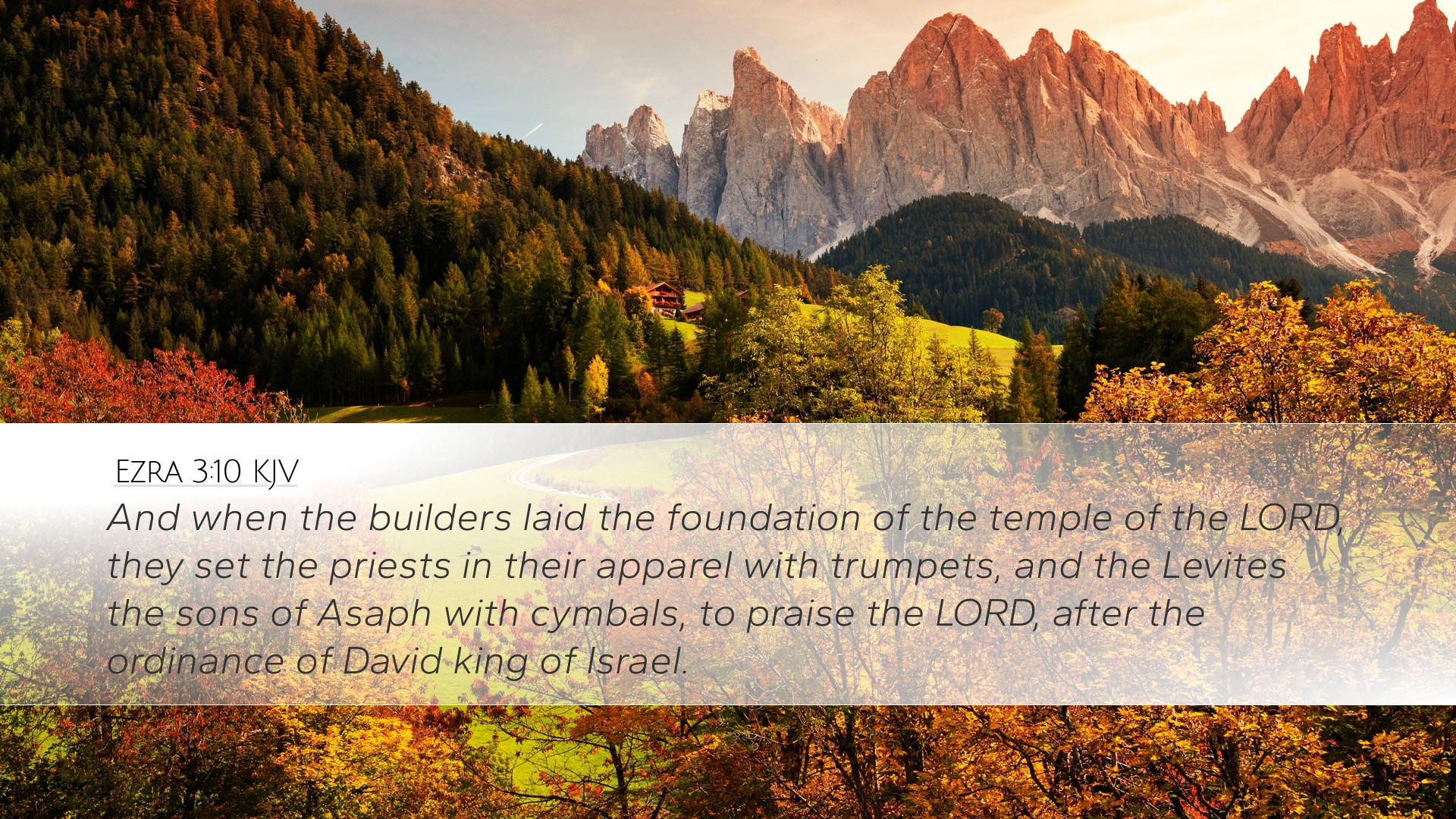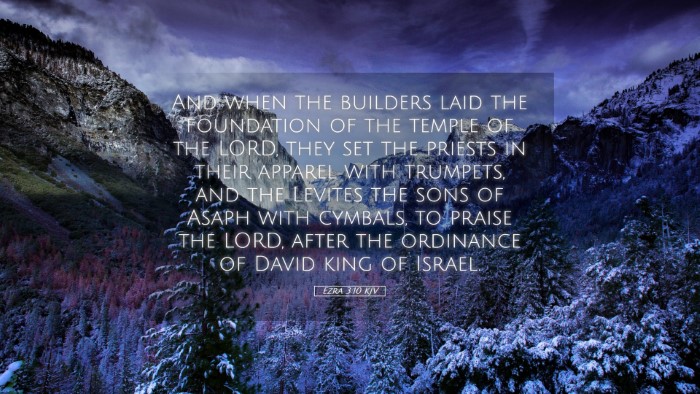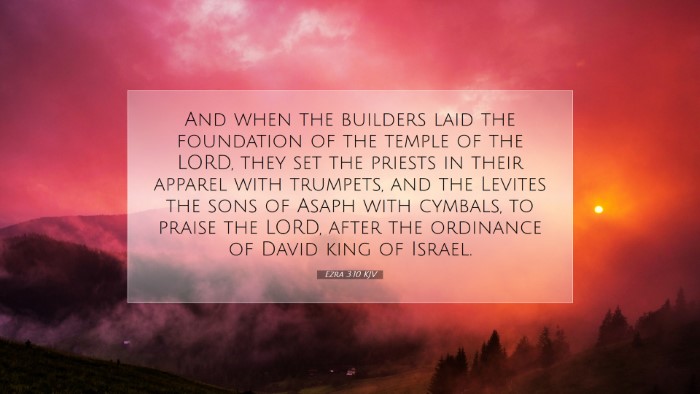Old Testament
Genesis Exodus Leviticus Numbers Deuteronomy Joshua Judges Ruth 1 Samuel 2 Samuel 1 Kings 2 Kings 1 Chronicles 2 Chronicles Ezra Nehemiah Esther Job Psalms Proverbs Ecclesiastes Song of Solomon Isaiah Jeremiah Lamentations Ezekiel Daniel Hosea Joel Amos Obadiah Jonah Micah Nahum Habakkuk Zephaniah Haggai Zechariah MalachiEzra 3:10
Ezra 3:10 KJV
And when the builders laid the foundation of the temple of the LORD, they set the priests in their apparel with trumpets, and the Levites the sons of Asaph with cymbals, to praise the LORD, after the ordinance of David king of Israel.
Ezra 3:10 Bible Commentary
Commentary on Ezra 3:10
Ezra 3:10 states: "And when the builders laid the foundation of the temple of the LORD, they set the priests in their apparel with trumpets, and the Levites, the sons of Asaph, with cymbals, to praise the LORD, after the ordinance of David king of Israel."
Introduction
This verse marks a pivotal moment in the history of Israel, as it signifies the rebuilding of the temple after the Babylonian exile. The laying of the foundation is not merely a construction project; it embodies the restoration of worship and communal life. This commentary will explore the significance of this event, drawing insights from Matthew Henry, Albert Barnes, and Adam Clarke.
Contextual Background
The return of the Jewish exiles was a fulfillment of prophetic promises. Ezra was among those who returned to Jerusalem with the mandate to rebuild the temple (Ezra 1:1-4). Understanding the cultural and historical background enhances our appreciation of this event.
Insights from Commentaries
Matthew Henry
Henry emphasizes the joyous occasion of laying the temple's foundation. He likens this moment to a new beginning for the people of Israel, recovering their dignity and establishing divine worship. According to Henry, this act of worship was a communal affirmation of their covenant relationship with God. He notes that the priests and Levites played a crucial role in this event, highlighting the significance of their garments and instruments:
- Priestly Garments: The attire of the priests signifies holiness and the importance of their role in mediating between God and the people.
- Musical Instruments: The use of trumpets and cymbals represents joy, celebration, and the pent-up emotions of the people as they engage in worship.
Albert Barnes
Barnes provides a theological perspective, focusing on the significance of the foundation itself. He posits that the foundation denotes the stability and permanence of God's dwelling among His people. Barnes elucidates several critical points:
- Symbol of Hope: The foundation symbolizes hope and a new beginning after a long period of desolation and exile.
- Role of Worship: The priests' presence underscores the necessity of worship in establishing a relationship with God, especially in recommencing communal practices.
- Continuity of Tradition: By following the ordinances established by David, the Israelites acknowledge their historical roots and the importance of faithfulness to the covenant.
Adam Clarke
Clarke's commentary furthers the discussion on the spiritual implications of the foundation-laying event. He points to the unity and purpose of the community in their worship:
- Community Engagement: Clarke highlights that this act was not an isolated event but rather involved the entire community. It was a collective act of worship that brought the people together.
- Spirit of Celebration: Clarke notes the profound joy and emotional release as the people praised the Lord. The joy of the people is a crucial aspect of their reestablished identity.
- Historical Significance: The emphasis on David’s ordinance links their present worship to their historical past, emphasizing the continuity of God’s plan through generations.
Theological Reflections
This moment serves as a reminder of God's faithfulness. The act of laying the foundation is both literal and figurative, pointing to the establishment of spiritual foundations in the hearts of the returning exiles. The presence of priests and Levites illustrates that worship and service are integral to the community's renewal.
Covenant Relationship and Worship
Worship, as highlighted by the priests in their sacred garments with trumpets and cymbals, plays a vital role in maintaining the covenant relationship with God. The restored temple becomes a tangible sign of God's presence again among His people.
Learning from the Past
The invocation of David's orders signifies the importance of learning from past leaders and maintaining fidelity to divine instructions. It serves as a call to modern believers to root their practices in the historical Christian tradition and scriptural principles.
Conclusion
Ezra 3:10 is a powerful reminder of the communal aspect of worship, the significance of tradition, and the hope that comes from God's faithfulness. As pastors, students, theologians, and scholars reflect on this text, they are encouraged to explore the interplay between historical context and spiritual renewal. The rebuilding of the temple stands as a metaphor for renewal in contemporary faith communities, calling believers to engage systematically and joyfully in worship and service.


